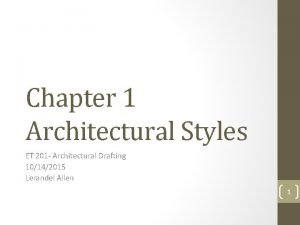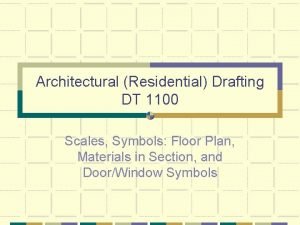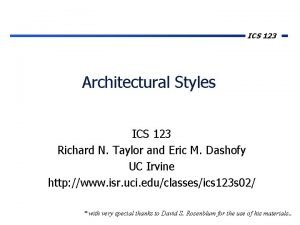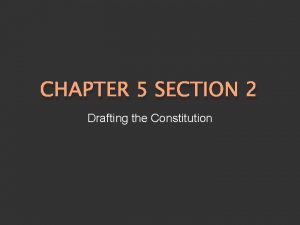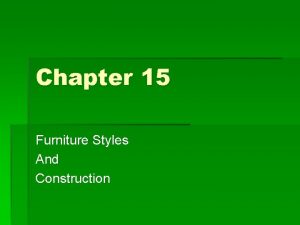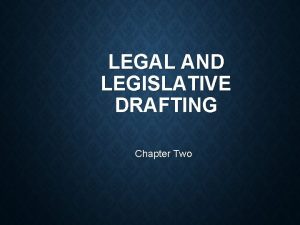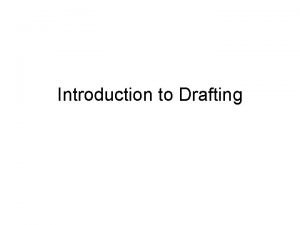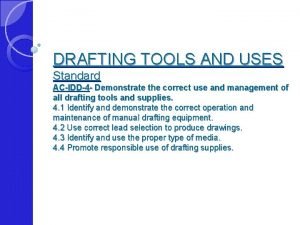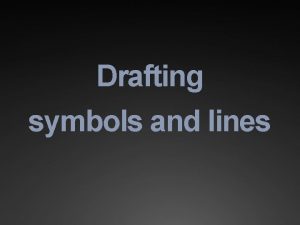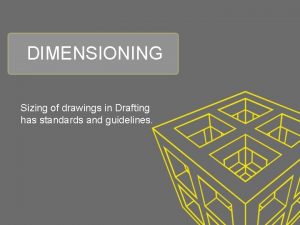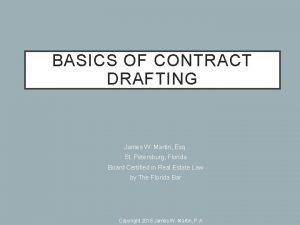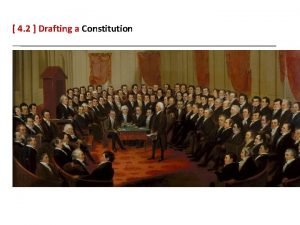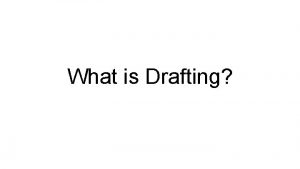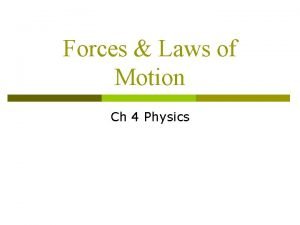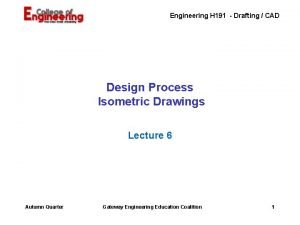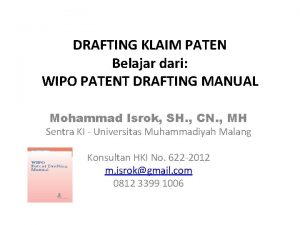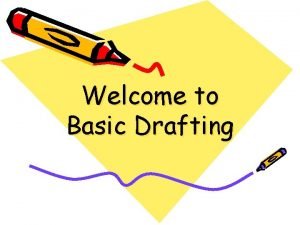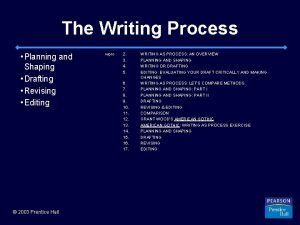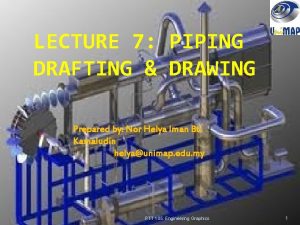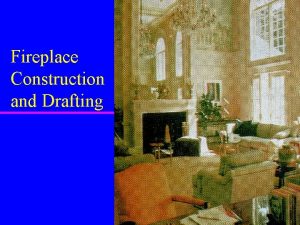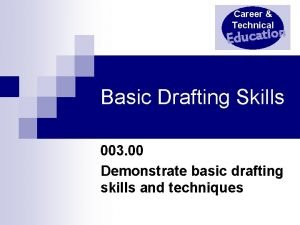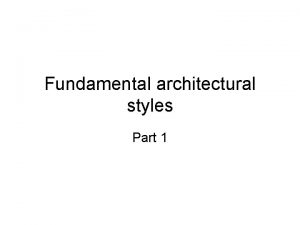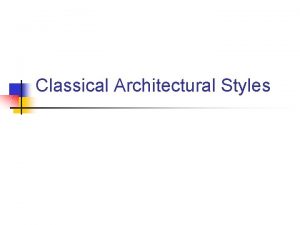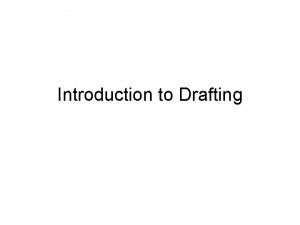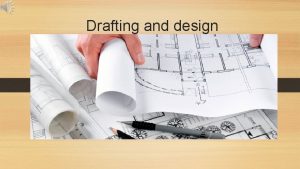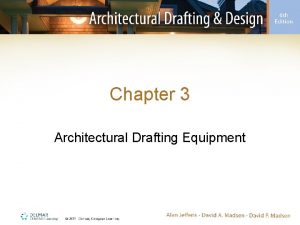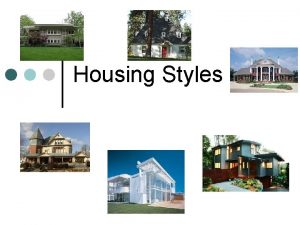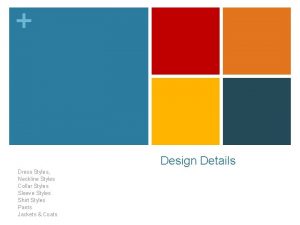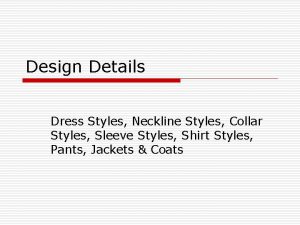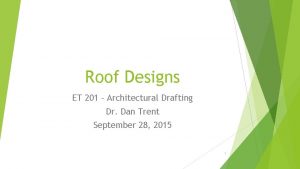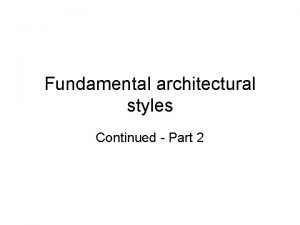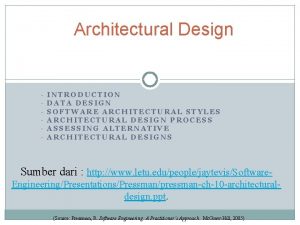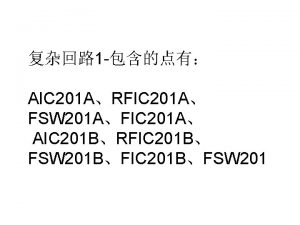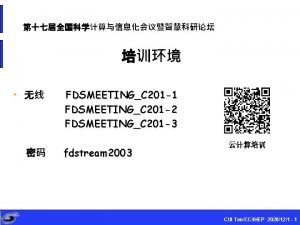Chapter 1 Architectural Styles ET 201 Architectural Drafting



































- Slides: 35

Chapter 1 Architectural Styles ET 201 - Architectural Drafting 10/14/2015 Lerandel Allen 1

Objectives • Describe traditional architectural styles used in the United States. • Explain how social and cultural ideas influence architecture. • Explain the historical design influences on today’s residential homes. • Identify types of multifamily housing • Describe current trends in architecture 2

Key Terms • Adobe • Apartment • Architectural Styles • Condominium • Cooperative • Craftsman period • Half-timbering • Mail-order house • Mansard roof • Modernism • Multifamily housing • Pattern books • Period home • Postmodernism • Romanticism • Townhouse • Victorian period 3

TRADITIONAL ARCHITECTURAL STYLES 4

• Wigwam • Small house usually made of wood frames covered with woven mats • Tipi • Cone shaped structure covered with animal hides • Longhouse • Rectangular and consisted of wood pole frames covered by bark or grass mats. • Adobe • A natural building material made of water, sand, clay, and straw Question 1 pages 22 -25 Native American Houses* mixed together, then formed into the desired shape • Earthen Houses • Built partially underground, the framework was covered with a layered system of smaller sticks, long grasses, woven mats, and earth 5

Adobe House 6

American Colonial Houses • Log Homes • Simple one roomed, gabled roof house built from large logs with a centrally located door and chimney • More interior space with a additional “lean to” structure, one half room deep, to the rear of the house • Cape Cod • Fairly small house with a gable roof and a massive central chimney located in line with the front door. Question 2 pages 26 -27 • Saltbox • Tidewater • House built along the coastline that has a porch that provides cool shelter from the hot sun and frequent rainstorms. * 7

• Spanish Colonial • Built of thick walls made of adobe brick or rubble stone, with few windows and multiple doors, and pitched or flat roof. • Georgian • Federal/Adam • Symmetrical, multistory dwellings with a low pitched or flat roof • More delicate and refined than the Georgian * Question 3 page 29 • Style that placed emphasis on symmetry and geometrical proportions • Pattern Books publications of treatises, essays, and books on architectural design and construction 8

Georgian 9

Romantic Styles • Covered entry with columns that resembled the look of a greek temple • Gothic revival • Steeply pitched, cross gabled roof with decorative gable trim Question 4 page 30 • Romanticism a revolt against the Enlightenment movement. Challenged the role of religion and emphasized the ability of humans to reason and change society. * • Greek Revival • Italianate • Square or rectangular and two or three stories high, with a flat or low pitched roof 10

Victorian Period • Same architectural style as a Italianate but have a mansard roof, *double pitched hip roof that allowed the top level be used for living space, and windows were less elaborate and arched. • Stick Question 5 page 32 • Victorian Period time of month when a woman must be treated like a queen such as queen Victoria or you will have hell to pay. • Second Empire • The exterior wall was the decorative element • Queen Anne • Asymmetrical forms, steeply pitched roofs , projecting gables, and patterned shingles. 11

Second Empire 12

Period Home Styles • A period home represented the past when the virtues of tradition were important. • Colonial Revival • Asymmetrical queen Anne structures with classical elements of roman and Greek design. • Spanish Eclectic • Asymmetrical façade, low pitched tile roofs, and prominent arch under tile roof, etc. • Tudor Revival • One and one-half or two and one half stories. The wood frame was covered with stucco, brick, stone, or wood, often with halftimbering , exposed hand hewn wood framing with masonry filled spaces 13

Tudor Revival 14

STYLES OF THE 20 TH CENTURY 15

• The craftsman period was a movement where the purpose was to renew the human spirit by reuniting art, labor, and artist while promoting hand workmanship. Available through mail order houses. * • Mail-order Houses affordable, mass-produced, unassembled houses in do it yourself kits. • Foursquare • A square house, one to two and one half stories, divided into four rooms per floor Question 6 page 36 Craftsman period • Bungalow • A rectangular one or one and one half story dwelling, usually with a low sloping gable roof with a wide overhang and a full or partial porch 16

Bungalow 17

Prairie • Form follows function • Open interior spaces • And merging architecture with nature. • Most noted architect Frank Lloyd Wright 18

Art Deco • United smooth surfaces, geometric shapes, and projections with strong vertical or horizontal lines to emphasize architectural features. 19

• Asymmetrical with smooth surfaces, often with curved corners, and a flat roof • Had roots in Bauhaus movement* Question 7 pages 38 -39 Art Moderne 20

• Embraced form, function, and new building technology • Bauhaus movement had a major influence * Question 7 pages 38 -39 International 21

Ranch • Long and low one story house style that developed from the homes built by ranchers in the south western United States. 22

Postmodern • Postmodernism marked the return of embellishment, and injected wit and character into architecture. • Generally characterized by the use of sculptural forms, ornaments, and materials to make a statement about the owner or architect 23

Neomodern • Emphasize form and function and reject the use of decoration and elements borrowed from past architectural styles 24

RESIDENTIAL ARCHITECTURE TODAY 25

Question 9 pages 41 -42 • Contemporary houses are the result of years of architectural design and evolution. • The need’s and finance of a family generally dictate the type and style of today’s construction. * • The ability of the architect or building designer to meet the client’s needs is equally important. * 26

Multifamily Housing are buildings that provide homes for more than one family MULTIFAMILY HOUSING 27

Cooperative • Cooperative refers to a type of ownership rather than a type of building • The building is owned and operated by a corporation • Each family’s living space is called a unit. • Each buyer buys a stock and become a shareholder and in return they receive a lease that grants them the right to occupy the unit. 28

Condominium Question 8 pages 42 -44 • A condominium is similar to cooperative but the owner buys the unit and a share of the common ground. * • The owner receives a deed on the unit and pays taxes on it 29

Townhouse • A townhouse is typically a two to four story house connected to one or more similar houses by a common wall. 30

Apartment • An apartment is living space that is available for rent. • Rent is money paid in exchange for the right to occupy and use the space. 31

TRENDS IN ARCHITECTURE 32

• Trends include creating designs for the homes that use or re-use: Existing building material Newly developed materials Materials and processes that are free of toxic chemicals Materials that are easily reusable “smart materials that can respond to environmental conditions Sustainable materials harvested from renewable natural resources. * Question 10 page 47 • • • 33

Summary • Traditional architectural styles were first brought to the American colonies by settlers from Europe and were adapted to use local materials and methods. ( Obj. 1 ) • Social and cultural attitudes affect architectural design in many ways, including use of materials and the extent of ornamentation. ( Obj. 2) 34

• Today’s architectural designs draw from traditional styles developed over hundreds of years. ( Obj. 3 ) • Cooperative, condominiums, and rental apartments are common forms of multifamily housing. ( Obj. 4 ) • Trends in residential architecture include designing for comfortable living and environmentally friendly housing. ( Obj. 5) 35
 Chapter 1 architectural styles
Chapter 1 architectural styles Material symbols architecture
Material symbols architecture Architectural styles
Architectural styles Architectural styles and patterns
Architectural styles and patterns Architectural styles
Architectural styles Ics123
Ics123 Chapter 5 section 2 drafting the constitution
Chapter 5 section 2 drafting the constitution Excessive use of ornamentation and massive proportions
Excessive use of ornamentation and massive proportions Drafting in writing process
Drafting in writing process Writing business messages
Writing business messages Legal drafting software
Legal drafting software Legal draftsman meaning
Legal draftsman meaning What is drafting
What is drafting Pde report gtu
Pde report gtu Used when drawing horizontal lines and support triangles
Used when drawing horizontal lines and support triangles Draft symbol in drawing
Draft symbol in drawing Instrument tool
Instrument tool Jis z 8311
Jis z 8311 Basics of contract drafting
Basics of contract drafting Views technical drawing
Views technical drawing Drafting of the constitution
Drafting of the constitution What is drafting
What is drafting An.1
An.1 H 191
H 191 Conclusion of drafting
Conclusion of drafting Wipo patent drafting manual
Wipo patent drafting manual Drafting community
Drafting community Drafting media
Drafting media Basic drafting tools
Basic drafting tools Planning drafting revising editing
Planning drafting revising editing Jet siphon drafting
Jet siphon drafting Components of introduction in research proposal
Components of introduction in research proposal Dependable lift drafting
Dependable lift drafting Double line piping drawing
Double line piping drawing Fireplace drafting
Fireplace drafting Basic drafting skills
Basic drafting skills
